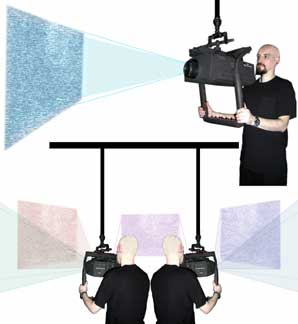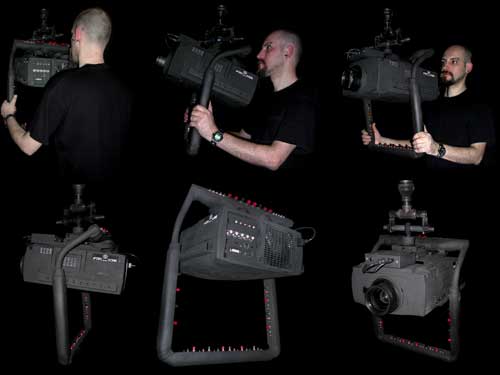|

|
|
"Protest"
a video remix performance by screaMachine using the recently
developed interactive projection device titled "V.R.A.G."
(video remix artillery gun). The V.R.A.G., a device created
by the artist, combines a data projector, a custom MIDI
controller and a swivel mount. When connected to a computer,
the artist can control the direction of the projection
beam and the video content by "playing" the
video clips like a MIDI musician plays a synthesizer.
Video and audio are output from this system.
The V.R.A.G. can be installed in any room or outdoor space
with electricity and surfaces to project onto. "Entertainment
rmx" also requires an audio system. The V.R.A.G.
is hung from a pipe structure: two upright stage pipes,
set in bases, connected by a cross beam (standard equipment
available at any staging supplier or plumbers supply).
The V.R.A.G. and computer use about 500 watts of power.
Additional power is necessary for the sound system.
|
| As
the projection moves around the room, the focus
of activity moves. By utilizing all surfaces
in the area, the artist redifines the space
and the traditional audience viewing experience. |
 |
|
 |
|
V.R.A.G.
(video remix artillery gun)
hung from ceiling.
The
artist controls both the direction of the
beam and the content of the video.
|
 |
|
|
 |
 |
 |
 |
 |
"Protest"
uses a series of animated video clips made available
for instant playback via the MIDI controller switches
on the V.R.A.G. These clips will be mixed live by the
artist as he projects them around the performance space.
The artist shot many hours of footage at the huge anti
war rally in New York City in February 2003. This footage
was then time remapped in an animation program such
that it pauses and zooms onto significant frames every
second. If these frames are 2 seconds apart, then those
2 seconds pass in 1 second, if they are 1 minute apart,
then a minute is compressed into 1 second, and equally
smaller time segments are expanded to fit the 1 second
template. The footage is then sorted and arranged into
clips to be played back from a video sampler via MIDI.
Each clip is combined with an appropriate audio field
recording: protest chants for marchers and banners,
cop sirens and loud hailer commands for police footage.
Once loaded into the sampler, each clip can be played
at any time and in any order, sped up, slowed down,
player forward/backward etc. The artist makes these
editing decisions live, alongside choosing where the
projection beam hits. The chaotic dynamic of the protest,
with its cacophony and immersive, surrounding action
is recreated in the gallery performance space. The animated
video clips appear like still images that can be navigated
through, with strange motion; these images give a further
sense of space and environment as they are mapped onto
the walls of the gallery space.
The use of stark, high-contrast black and white further
enhances the polarity of the imagery: the opposing forces,
the peacemakers versus the riot cops, freedom versus
containment, chants versus commands etc. A similar dichotomy
is played out in the performance iconography; a performer,
in military style clothing, operating a device that
mimics an artillery gun, fills the space with a loud
and assertive plea for peace.
|
 |
 |
 |
 |

|

  

|
 |

